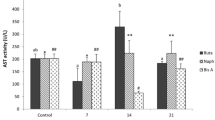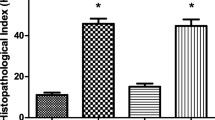Abstract
The effects of cypermethrin-based insecticide (CBI), commonly used in aquaculture and agriculture, were evaluated in matrinxa (Brycon amazonicus) exposed to sub-lethal concentration (20% of LC50) for 96 h. Physiological and biochemical effects were studied through biomarkers: lipid peroxidation (LPO), glutathione (GSH), and ascorbic acid concentrations; superoxide dismutase (SOD), catalase (CAT), glutathione peroxidase (GPx), and glucose-6-phosphate dehydrogenase (G6PDH) assays in the liver and gills. Besides, ions Na+, Cl−, and K+; protein and glucose concentrations were measured in the plasma. Red blood cells count (RBC), hemoglobin concentration (Hb), hematocrit (Ht), and hematimetric parameters were evaluated in the total blood. The NKA (Na+ /K+ ATPase) activity was assayed in the gills. The histopathological effects of CBI were also investigated in the gills. The liver and gill LPO increased 62 and 100%, respectively. The tripeptide GSH concentration reduced in the liver and increased in the gill of exposed fish. The SOD and CAT activities increased in the liver, whereas CAT reduced in the gill. Liver also presented an increase in G6PDH activity. Plasma Na+ and Cl− and glucose concentrations increased in the exposed fish. Levels of Ht, Hb and RBC were significantly increased. The gill NKA activity also increased. Exposed fish exhibited histological alterations in the gills such as hypertrophy and proliferation of chloride cells, blood vessels dilation, aneurysms and hemorrhage of the lamella. The histological index indicated moderate to heavy damage to the gills. CBI provokes liver and gills oxidative stress, gill structural damages, and ionic imbalance. A multi-biomarker approach allows us to see that B. amazonicus was unable to cope with CBI exposure.

Similar content being viewed by others
References
Abdelkhalek NKM, Ghazy EW, Abdel-Daim MM (2015) Pharmacodynamic interaction of Spirulina platensis and deltamethrin in freshwater fish Nile tilapia, Oreochromis niloticus: impact on lipid peroxidation and oxidative stress. Environ Sci Pollut R 22:3023–3031
Al-Ghanbousi R, Ba-Omar T, Victor R (2012) Effect of deltamethrin on the gills of Aphanius dispar: A microscopy study. Tissue Cell 44:7–14
Ansari RA, Rahman S, Kaur M, Anjum S, Raisuddin S (2011) In vivo cytogenetic and oxidative stress-inducing effects of cypermethrin in freshwater fish. Channa punctata Bloch Ecotox Environ Safe 74:150–156
ANVISA (2007). Agência Nacional de Vigilância Sanitária. Consulta pública no 64, de 11 de Julho de 2007. http://www4.anvisa.gov.br/base/visadoc/CP/CP%5B19072-1-0%5D.PDF
APHA American Public Health Association (1980) Standard methods for examination of water and wastes, 12 ed. Join editorial board, Washington, DC
Arslan H, Ozdemir S, Altun S (2017) Cypermethrin toxication leads to histopathological lesions and induces inflammation and apoptosis in common carp (Cyprinus carpio L.). Chemosphere 180:491–499
Bacchetta C, Rossi A, Ale A, Campana M, Parma MA, Cazenave J (2014) Combined toxicological effects of pesticides: a fish multi-biomarker approach. Ecol Indic 36:532–538
Belluta I, Almeida AA, Coelho JC, Nascimento AB, Silva AMM (2010) Avaliação Temporal e espacial no córrego do Cintra (Botucatu-SP) frente aos defensivos agrícolas e parâmetros físico-químicos de qualidade de água—um estudo de caso. Rev Energ na Agric 25:54–73
Beutler E (1984) Red cell metabolism: manual of biochemical methods, 3th edn. Grune and Stratton, INC
Bonansea RI, Wunderlin DA, Amé MV (2016) Behavioral swimming effects and acetylcholinesterase activity changes in Jenynsia mutidentata exposed to chlorpyrifos and cypermethrin individually and in mixtures. Ecotox Environ Saf 129:311–319
Borges A, Scotti LV, Siqueira DR, Zanini R, Amaral F, Jurinitz DF, Wassermann GF (2007) Changes in hematological and serum biochemical values in jundiá Rhamdia quelen due to sub-lethal toxicity of cypermethrin. Chemosphere 69:920–926
Carr RS, Bally MB, Thomas P, Neff JM (1983) Comparison of methods for determination of ascorbic acid in animal tissues. Anal Chem 55:1229–1236
Coats JR (2008) Toxicology of Synthetic Pyrethroid Insecticides. In: Di Giulio RT, Hinton DE (eds) The Toxicology of fishes. CRC Press, Taylor & Francis Group, Boca Raton, FL, p 805–818
Dawar FU, Zuberi A, Azizulahh A, Khattak MNK (2016) Effects of cypermethrin on survival, morphological and biochemical aspects of rohu (Labeo rohita) during early development. Chemosphere 144:697–705
Di Giulio RT, Meyer JN (2008) Reactive Oxygen Species and Oxidative Stress. In: Di Giulio RT, Hinton DE (eds) The Toxicology of fishes. CRC Press, Taylor & Francis Group, Boca Raton, FL, p 273–326
Drabkin DL (1948) The standardization of hemoglobin measurement. Am J Med Sci 215(1):110–111
Elliott M (1976) Properties and applications of pyrethroids. Environ Health Persp 14:3–13
EMEA European Medicines Agency (2003) Committee for Veterinary Medicinal Products, Cypermethrin (Extension for Salmonidae), The European Agency for the Evaluation of Medical Products, Veterinary Medicines and Inspections, EMEA/MRL/861/03, p 1–3
Ensibi C, Pérez-López M, Rodríguez FS, Míguez-Santiyán MP, Yahya MND, Hernández-Moreno D (2013) Effects of deltamethrin on biometric parameters and liver biomarkers in common carp (Cyprinus carpio L.). Environ Toxicol Phar 36(2):384–391
Gutterigde JMC (1995) Lipid peroxidation and antioxidants as biomarkers of tissue damage. Clin Chem 41/42:1819–1828
Hart JL, Thacker JRM, Braidwood JC, Fraser NR, Matthews JE (1997) Novel cypermethrin formulation for the control of sea lice on salmon (Salmo salar). Vet Rec 140:179–181
Haya K (1989) Toxicity of pyrethroid insecticide to fish. Environ Toxicol Chem 8:381–391
Haya K, Burridge L, Davies I, Ervik A (2005) A review and assessment of environmental risk of chemicals used for the treatment of sea lice infestations of cultured salmon. In: Hargrave B (ed) The Handbook of Environmental Chemistry, Environmental Effects of Marine Finfish Aquaculture. Springer-Verlag, Berlin Heidelberg, p 305–340
Inoue LAKA, Santos-Neto C, Moraes G (2003) Clove oil as anaesthetic for juveniles of matrinxã Brycon amazonicus (Gunther, 1869). Cienc Rural 33:943–947
Jiang ZY, Hunt JV, Wolff SP (1992) Ferrous ion oxidation in the presence of xylenol orange for detection of lipid hydroperoxide in low-density lipoprotein. Anal Biochem 202:384–389
Jha AN (2008) Ecotoxicological applications and significance of the comet assay. Mutagenesis 23(3):207–221
Kan Y, Cengiz EI, Ugurlu P, Yanar M (2012) The protective role of vitamin E on gill and liver tissue histopathology and micronucleus frequencies in peripheral erythrocytes of Oreochromis niloticus exposed to deltamethrin. Environ Toxicol Phar 34:170–179
Kelly SA, Havrilla CM, Brady TC, Abramo KH, Levin ED (1998) Oxidative stress in toxicology: established mammalian and emerging piscine model systems. Environ Health Persp 106:375–384
Kleinow KM, Nichols JW, Hayton WL, McKim JM, Barrom MG (2008) Toxicokinetics in Fishes. In: Di Giulio RT, Hinton DE (eds) The Toxicology of fishes. CRC Press, Taylor & Francis Group, Boca Raton, FL, p 55–152
Kono Y, Fridovich I (1982) Superoxide radical inhibits catalase. J Biol Chem 257:5751–5754
Korkmaz N, Cengiz EI, Unlu E, Uysal E, Yanar M (2009) Cypermethrin-induced histopathological and biochemical changes in Nile tilapia (Oreochromis niloticus), and the protective and recuperative effect of ascorbic acid. Environ Toxicol Phar 28:198–205
Kruger NJ (1994) The Bradford method for protein quantification. Walker JM (ed) Methods in Molecular Biology, Basic Protein and Peptide Protocols vol 32. Humana Press Inc, Totowa, 15–21
Kumar S, Lata S, Gopal K (1999) Deltamethrin induced physiological changes in freshwater catfish Heteropneustes fossilis. B Environ Contam Tox 62:254–258
Lushchak VI (2011) Environmentally induced oxidative stress in aquatic animals. Aquat Toxicol 101:13–30
Marino D, Ronco A (2005) Cypermethrin and Chlorpyrifos concentration levels in surface water bodies of the Pampa Ondulada, Argentina. B Environ Contam Tox 75:820–826
Moraes FD, Venturini FP, Cortella LRX, Rossi PA, Moraes G (2013) Acute toxicity of pyrethroid-based insecticides in the Neotropical freshwater fish Brycon amazonicus. Ecotox Environ Contam 8(2):59–64
Mu X, Shen G, Huang Y, Luo J, Zhu L, Qi S, Li Y, Wang C, Li X (2017) The enantioselective toxicity and oxidative stress of beta-cypermethrin on zebrafish. Environ Pollut 229:312–320
Narahashi T (1996) Neuronal ion channel as the target sites of insecticides. Pharmacol Toxicol 79:1–14
NPIC—National Pesticide Information Center (1998). Cypermethrin, p 1–4 http://npic.orst.edu/factsheets/cypermethrin.pdf
Perry SF (1997) The chloride cell: structure and function in the gills of freshwater fish. Annu Rev Physiol 59:325–347
Pickering AD, Pottinger TG (1995) Biochemical effects of stress. In: Hochachka, Mommsen (eds) Biochemistry and molecular biology of fishes vol 5. Elsevier Science BV, Amsterdam, p 349–379
Pimpão CT, Zampronio AR, Assis HCS (2007) Effects of deltamehrin on hematological parameters and enzymatic activity in Ancistrus multispinis (Pisces, Teleostei). Pestic Biochem Phys 88:122–127
Piner P, Üner N (2012) Oxidative and apoptotic effects of lamba-cyhalothrin modulated by piperonyl butoxide in the liver of Oreochromis niloticus. Environ Toxicol Phar 33:414–420
Poleksic V, Mitrovic-Tutundzic V (1994) Fish gills as a monitor of sublethal and chronic effects of pollution. In: Muller R, Lloyd R (eds) Sublethal and chronic effects of pollutants on freshwater fish. Fishing News Books, Oxford, p 339–352
Quabius ES, Balm PHM, Wenderlaar Bonga SE (1997) Interrenal stress responsiveness of tilapia (Oreochromis mossambicus) is impaired by dietary exposure to PCB 126: general and comparative. Endocrinology 108:472–482
Sayeed I, Parvez S, Pandey S, Bin-Hafeez B, Haque R, Raisuddin S (2003) Oxidative stress biomarkers of exposure to deltamethrin in freshwater fish, Channa punctatus Bloch. Ecotox Environ Safe 56:295–301
SEPA Scottish Environmental Protection Agency (1998) SEPA policy on the use of cypermethrin in marine fish farming risk assessment, EQS and recommedations. http://sepa.org.uk/aquaculture/policies/index.htm Policy No. 30
Soderlund DM, Clark JM, Sheets LP, Mullin LS, Piccirillo VJ, Sargent D, Stevens JT, Weiner ML (2002) Mechanisms of pyrethroid neurotoxicity: implications for cumulative risk assessment. Toxicology 171:3–59
Suvetha L, Ramesh M, Saravana M (2010) Influence of cypermethrin toxicity on ionic regulation and gill Na+/K+- ATPase activity of a freshwater teleost fish Cyprinus carpio. Environ Toxicol Phar 29:44–49
Trinder P (1969) Determination of blood glucose using 4-amino phenazone as oxygen receptor. Ann Clin Biochem 6:24
Tu W, Lu B, Niu L, Xu C, Lin C, Liu W (2014) Dynamics of uptake and elimination of pyrethroid insecticides in zebrafish (Danio rerio) eleutheroembryos. Ecotox Envirnon Safe 107:186–191
US EPA United States Environmental Protection Agency (2006) Reregistration Eligibility Decision for Cypermethrin (revised 01/14/08). https://archive.epa.gov/pesticides/reregistration/web/pdf/cypermethrin_revised_red.pdf
Verma SR, Rani S, Tyagi AK, Dalela RC (1980) Evaluation of acute toxicity of phenol and its chloro- and nitro-derivates to certain teleosts. Water Air Soil Poll 14:95–102
Vieira HP, Neves AA, Queiroz MELR (2007) Otimização e validação da técnica de extração líquido-líquido com partição em baixa temperatura (ELL-PBT) para piretroides e análise por CG. Quím Nova 30(3):535–540
Wintrobe MM (1934) Variations in size and hemoglobin content of erythrocytes in the blood of various vertebrates. Folia Haematol 51:32–49
WHO-World Health Organization (1989) Environmental Health Criteria 82, Cypermethrin, Geneva
Acknowledgements
The authors are thankful to Department of Genetics and Evolution, and colleagues of the Laboratory of Adaptive Biochemistry at the Federal University of Sao Carlos, Sao Paulo, for logistical support. In particular, we acknowledge Mr. Antônio D. A. Silva and Dr. Claudinei Cruz by technical support. We are also thankful to Ikdip Brar (from Canada) for English revision. This work was supported by Brazilian National Council for Scientific and Technological Development (CNPq process 143192/2009-4) as a doctorate scholarship for F.D. Moraes.
Author information
Authors and Affiliations
Corresponding author
Ethics declarations
Conflict of interest
The authors declare that they have no conflict of interest.
Ethical approval
All procedures and experimental conditions involving animals were in accordance with the ethical standards and was approved by the Ethics Committee for Animal Research of the Federal University of Sao Carlos, under the license number CEUA 056/2011.
Rights and permissions
About this article
Cite this article
de Moraes, F.D., Venturini, F.P., Rossi, P.A. et al. Assessment of biomarkers in the neotropical fish Brycon amazonicus exposed to cypermethrin-based insecticide. Ecotoxicology 27, 188–197 (2018). https://doi.org/10.1007/s10646-017-1884-2
Accepted:
Published:
Issue Date:
DOI: https://doi.org/10.1007/s10646-017-1884-2




